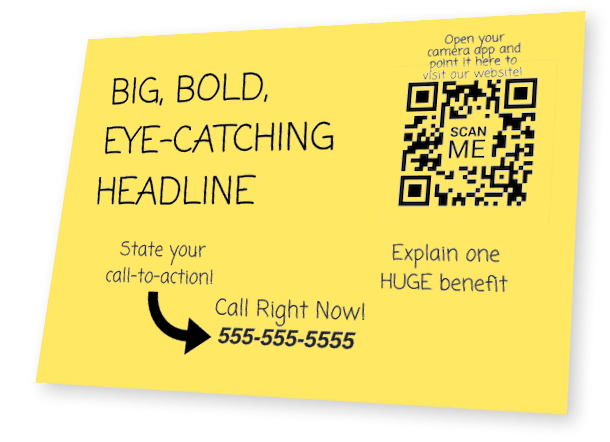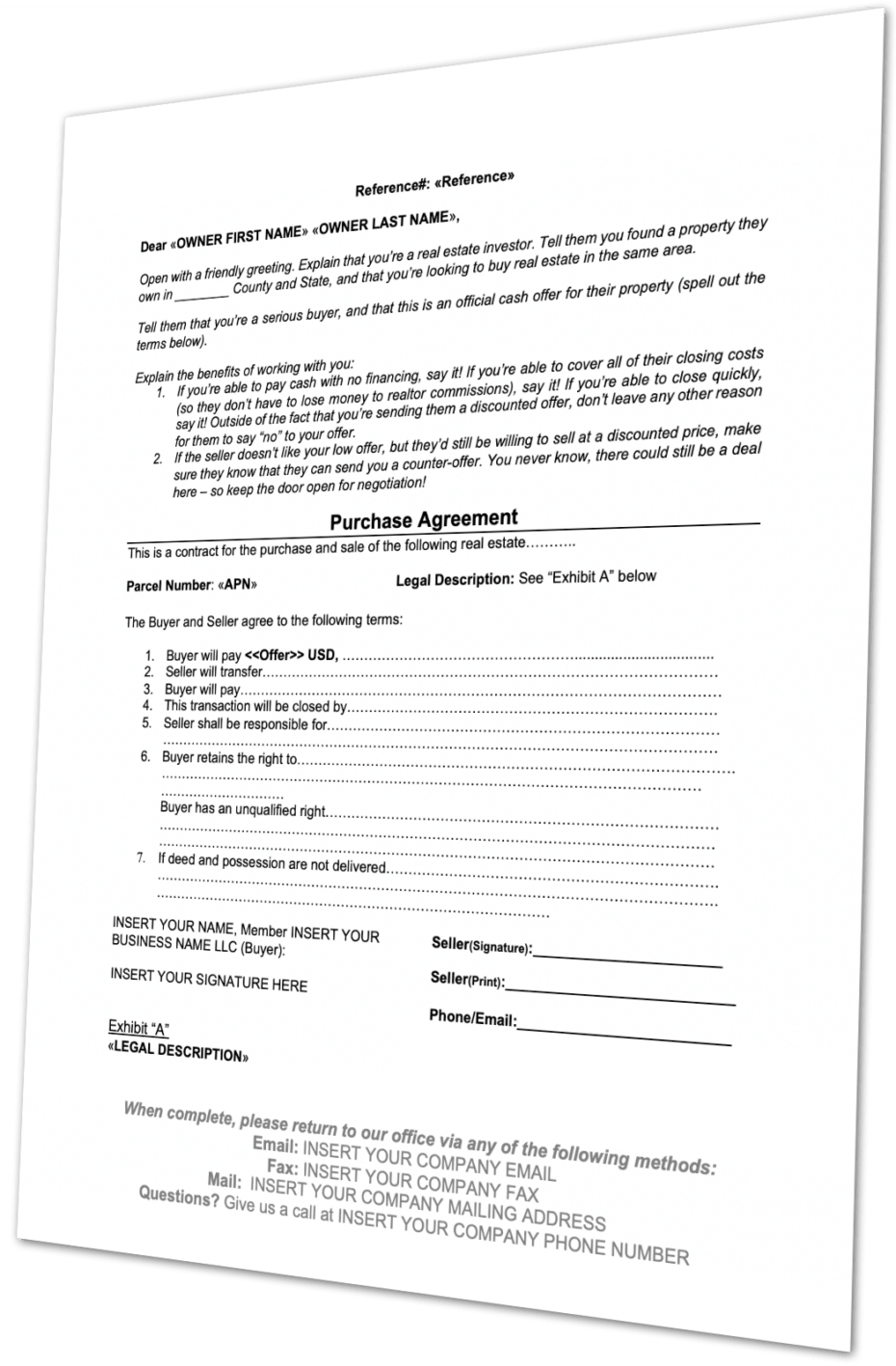
When it comes to direct mail marketing for real estate investors, there are a lot of options to choose from.
Direct mail can be as creative as you want it to be – I’ve seen everything from hot pink postcards to video cards to full-on gift baskets.
The problem is – when it comes to marketing, the law of diminishing returns comes into play.
For example, if we consider a video card (where the recipient opens a card that automatically plays a marketing video), this can be very powerful and have a high conversion rate, but the cost for that high conversion rate might not justify it.
Let’s say we have a marketing budget of $1,500 per month and we want to compare a video card campaign to a postcard campaign. Suppose with your budget, you could only afford to send out 300 video cards but with postcards, you could send out 3,000.
With a video card, you’ll typically get a higher response rate because it’s such an unusual type of mail piece… but they cost upwards of $30 per piece, so $3,000 worth of video cards will only cover about 300 properties.
On the other hand, postcards (by the sheer fact that they are so cheap) will allow you to send out far more units of mail.
Of course, all this depends on what type of real estate investing you do and what the nuances of your industry are, but generally speaking, I’ve found this to be the case for what I do, in my business.
Now, where a video card campaign might be more beneficial is if your list is small and your goal is to optimize your results.
Say I wanted to send out a campaign to my small town of 30,000 people looking for commercial multifamily and there were only 100 addresses that met my criteria. In this case, doing something like a video card campaign might be more efficient because it would likely yield a higher conversion rate compared to postcards.
When you're just getting started with direct mail, deciding what kind of campaign you want to do can be pretty overwhelming, so I want to help you sort through the noise and come up with some good options.
In my experience, there are three primary methods of direct mail that work well for real estate investing:
- Neutral Letters
- Postcards
- Blind Offers
Each option has its own set of pros and cons, so my goal is to provide an overview of each, helping you decide which one works best for your unique situation.
Neutral Letters

One of the more common forms of neutral letters in real estate is the iconic yellow letter, which is either handwritten or has a handwritten font, on a piece of paper that looks like it was ripped off of a yellow legal pad.
The distinguishing factor of a neutral letter is that it is more generic in nature compared to a blind offer.
A neutral letter lets people know you’re a real estate investor and that you’re interested in purchasing their property but directs them to get in touch with you prior to you sending them an offer.
With a neutral letter, you don't determine your offer amount until after they’ve made contact with you.
If you’re a land investor, this type of direct mail campaign can work well if you're working in a market that has a lot of variety between properties (more on this in a moment, when we go over blind offers).
Benefits of Neutral Letters:
- Maximum control over your offers on each individual property
- Opportunity to build rapport with the seller and make deals happen on a property-by-property basis
Sometimes a great deal might be worth your while to offer a higher percentage of market value (more than you normally would on an “average” property in a blind offer campaign), and you can do this very easily when you're sending out neutral letters.
With neutral letters, you get the opportunity to determine each property's value, desirability and gauge the seller's level of motivation on a case-by-case basis, whereas with a blind offer campaign, you won't have this luxury.
Drawbacks of Neutral Letters:
- Wasted time communicating with sellers who won't sell at the purchase price you need.
- The slightly higher cost of postage compared to a postcard.
The single biggest drawback of neutral letters is that you will inevitably waste more time talking to people that aren’t willing to sell their property at a discount.
For real estate investors who want to avoid unmotivated sellers and spend the least amount of time finding deals, this drawback is a big one… so if time is not something you (or your team) have an abundance of, this may not be the best option.
Postcards

If your goal is to do the highest volume and reach as many prospects as possible, this is going to be a great option because of the low cost of production.
Postcards are also very effective at being seen.
Unlike a neutral letter or blind offer (both of which are enclosed in an envelope), the recipient of a postcard (especially a double-sided postcard) has no choice but to see your message, even if it's for a split second before they throw it away.
The challenge, however, is making sure you're using good ad copy on the limited space you have available.
There are a variety of different sizes you can use for postcards, but what I’ve found to be the most common is 6in X 4.25in, which means you have to be smart about how you use the space.
In practice, postcards function very similarly to neutral letters, where the investor has to determine their offer price after the seller has made contact.
Some things you can do to optimize a postcard or a neutral letter campaign is testing handwritten vs. typed font, paper colors, using pictures vs. no pictures, or a print quality that’s thicker, glossy and professional looking vs. something more personal.
Benefits of Postcards:
- Maximum control over your offers on each individual property.
- Opportunity to build rapport with the seller and make deals happen on a property-by-property basis.
- Least expensive type of mail piece, allowing you to reach more prospects for less money.
- The easiest way to ensure the message is seen before the mailpiece is discarded.
Drawbacks of Postcards:
- Wasted time communicating with sellers who won't sell at the purchase price you need.
It's also possible to integrate a buying website with your postcard campaigns, so each recipient has the option of visiting your website and submitting their property information instead of calling you and getting into a long conversation about their property.
RELATED: Sending Offers In My Sleep
Blind Offers

These are typically one or two pages in an envelope, and they are sent with an actual offer to buy the property directly from the owner. This means the investor has to determine their offer amount first and then send out purchase agreements as part of the mail piece.
From a time perspective, blind offers are arguably the most efficient and scalable type of campaign because you only deal with three responses:
- Rejections
- Acceptances
- Negotiations
Compared to a neutral letter or postcard, it is MUCH easier to manage leads with a blind offer campaign, because the seller knows from the first point of contact that your offer is going to be very low.
Blind offers allow you to set proper expectations from the outset, avoiding most misunderstandings about the fact that you do not intend to pay full market value for this property.
However, there are a few significant drawbacks to this approach as well.
You will inevitably lose deals because sellers will be turned off by your low offer as the first point of contact.
You will miss opportunities because you're sacrificing the ability to look individually at each property and understand the seller's situation before you submit an offer. Sometimes a deal can easily justify a higher offer amount, but that opportunity will be overlooked because you aren't taking the time to assess the property on a case-by-case basis.
Not to mention, the cost of sending out 1 – 2 pages in an envelope will be more than the cost of sending out postcards, so effectively, you won't be able to reach as many people with the same budget.
Benefits of Blind Offers:
- Significantly more efficient and scalable.
- Very effective at setting realistic expectations with each seller from the first point of contact.
Drawbacks of Blind Offers:
- Lost deals from sellers who are turned off by your low offer with no prior communication.
- Missed opportunities with the inability to send tailored offer amounts based on the unique factors of each property.
- More time required in each campaign to understand local property values and price each offer effectively.
- The slightly higher cost of postage compared to a postcard.
For an investor who doesn't have time to haggle, negotiate and build rapport with sellers, the efficiency of blind offers is a very compelling reason to consider – but as I mentioned earlier, if your market has a lot of variation between properties and/or if you have a natural skill for closing deals over the phone, neutral letters or postcards might be a better option in the long run.
The key to success with blind offers is, you need to have a firm grasp on property values in the area you're sending mail to, and you need to understand how to translate those values to the prices you put in your blind offers.
Not just on a county-wide basis, and not just based on the type and size of the property – you need to drill down even deeper to the city, township, zip code and even subdivision where you're sending offers, and differentiate based on the uniqueness of the properties you're marketing for.
This obviously requires a lot more time and effort before you send out your mail, because property values fluctuate based on location, features, road access, utility access, water access, views, schools, improvements and more – so the further you can drill down, the better.
…but of course, this is the whole problem with blind offers.
Without digging deep into the details of each individual property and its characteristics, there’s only so much precision you can achieve when sending out thousands of offers at a time. At some point, you’ll have to cut your losses and move forward in order to maintain the benefit of efficiency.
If you're working in an area without much variation (a giant swath of flat desert with virtually no distinguishing factors between each parcel), it's pretty easy to price a blind offer campaign, because there isn't much complexity to account for. However, if you're working in a densely populated area with different features and access rights that change from one block to the next, it can be much harder to price blind offers effectively.
When your market has a lot of variation between the types of comparables available, neutral letters or postcards are oftentimes a better option. Even though these will require more time to understand each property before making the offer, you'll catch a lot more opportunities that otherwise would bee lost on an uneducated blind offer campaign.
The Verdict
There is a time and a place for each direct mail strategy, depending on the circumstances of who you're sending mail to, what market you're working in and what property types you're targeting – so take the time to understand what circumstances you're dealing with, and do this before you spend hundreds or thousands on a direct mail campaign.









